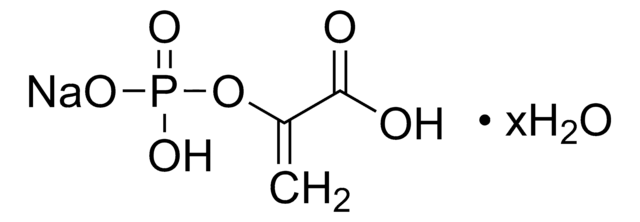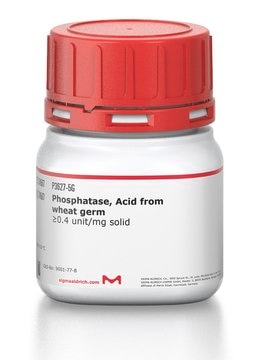P3637
Phospho(enol)pyruvic acid cyclohexylammonium salt
≥97% (enzymatic)
Synonyme(s) :
2-(Phosphonooxy)-2-propenoic acid monopotassium salt
Se connecterpour consulter vos tarifs contractuels et ceux de votre entreprise/organisme
About This Item
Formule empirique (notation de Hill):
C3H4O6P · C6H14N
Numéro CAS:
Poids moléculaire :
267.22
Numéro CE :
Numéro MDL:
Code UNSPSC :
12352100
ID de substance PubChem :
Nomenclature NACRES :
NA.22
Produits recommandés
Niveau de qualité
Essai
≥97% (enzymatic)
Forme
powder
Température de stockage
−20°C
Chaîne SMILES
NC1CCCCC1.OC(=O)C(=C)OP(O)(O)=O
InChI
1S/C6H13N.C3H5O6P/c7-6-4-2-1-3-5-6;1-2(3(4)5)9-10(6,7)8/h6H,1-5,7H2;1H2,(H,4,5)(H2,6,7,8)
Clé InChI
VHFCNZDHPABZJO-UHFFFAOYSA-N
Catégories apparentées
Actions biochimiques/physiologiques
Phospho(enol)pyruvic acid (PEP) is involved in glycolysis and gluconeogenesis. In glycolysis, PEP is metabolized by pyruvate kinase to yield pyruvate. In plants, PEP is involved in the formation of aromatic amino acids as well as in the carbon fixation pathway.
Code de la classe de stockage
11 - Combustible Solids
Classe de danger pour l'eau (WGK)
WGK 3
Point d'éclair (°F)
Not applicable
Point d'éclair (°C)
Not applicable
Équipement de protection individuelle
Eyeshields, Gloves, type N95 (US)
Faites votre choix parmi les versions les plus récentes :
Déjà en possession de ce produit ?
Retrouvez la documentation relative aux produits que vous avez récemment achetés dans la Bibliothèque de documents.
Les clients ont également consulté
Yuval Hart et al.
BMC systems biology, 5, 171-171 (2011-10-26)
C(4) plants such as corn and sugarcane assimilate atmospheric CO(2) into biomass by means of the C(4) carbon fixation pathway. We asked how PEP formation rate, a key step in the carbon fixation pathway, might work at a precise rate
S Mazurek et al.
Journal of bioenergetics and biomembranes, 29(4), 315-330 (1997-08-01)
A common characteristic of tumor cells is the constant overexpression of glycolytic and glutaminolytic enzymes. In tumor cells the hyperactive hexokinase and the partly inactive pyruvate kinase lead to an expansion of all phosphometabolites from glucose 6-phosphate to phosphoenolpyruvate. In
U Theobald et al.
Biotechnology and bioengineering, 55(2), 305-316 (1997-07-20)
The goal of this work was to obtain rapid sampling technique to measure transient metabolites in vivo. First, a pulse of glucose was added to a culture of the yeast Saccharomyces cerevisiae growing aerobically under glucose limitation. Next, samples were
D Allan Butterfield et al.
Journal of neurochemistry, 111(4), 915-933 (2009-09-29)
Enolase enzymes are abundantly expressed, cytosolic carbon-oxygen lyases known for their role in glucose metabolism. Recently, enolase has been shown to possess a variety of different regulatory functions, beyond glycolysis and gluconeogenesis, associated with hypoxia, ischemia, and Alzheimer's disease (AD).
Marcel Emmerling et al.
Journal of bacteriology, 184(1), 152-164 (2001-12-14)
The intracellular carbon flux distribution in wild-type and pyruvate kinase-deficient Escherichia coli was estimated using biosynthetically directed fractional 13C labeling experiments with [U-13C6]glucose in glucose- or ammonia-limited chemostats, two-dimensional nuclear magnetic resonance (NMR) spectroscopy of cellular amino acids, and a
Notre équipe de scientifiques dispose d'une expérience dans tous les secteurs de la recherche, notamment en sciences de la vie, science des matériaux, synthèse chimique, chromatographie, analyse et dans de nombreux autres domaines..
Contacter notre Service technique









